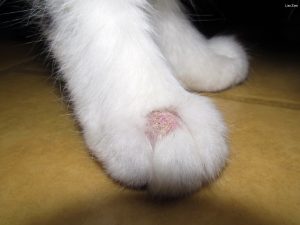
One of the most dangerous conditions a dog may contract is Ringworm.
Although it is called Ringworm, this condition is not caused by a worm. It is a fungus that grows in the outermost layer of skin and in the hair follicles of infected dogs. Sometimes, the nails may also be affected. While it is not fatal, this disease is highly contagious and will require the help of a professional veterinarian.
Symptoms of Ringworm in dogs may include the following:
1. Bald patches or thinning of the fur: Ringworm can cause the hair to fall out or become thin, leading to bald patches on the skin.
2. Scaling or crusting of the skin: The infected area may also be covered in scales or crusts.
3. Redness or irritation of the skin: The affected area may be red and inflamed.
4. Itching: Dogs with ringworm may also exhibit itching or scratching at the affected area.
If your dog experiences any hair loss, contact your veterinarian immediately. Ringworm usually manifests as circular patches of hair loss on the body. In addition to hair loss, other symptoms include dry, brittle hair; scabby, inflamed skin; and rough, brittle claws. Your veterinarian will perform a diagnostic test and physical exam to confirm ringworm. This may involve taking a sample of hair or skin cells for a fungal culture or examining infected hairs under an ultraviolet light called a Woods lamp.
The most effective course of action for treating Ringworm in dogs typically involves three steps: topical therapy, oral medications, and environmental decontamination. This means regularly cleaning pet blankets and other bedding from your cat or dog’s quarters. Remove pet hair from your home regularly by brushing your pet, vacuuming often, and disinfecting common areas where your pets live.
Ringworm is typically treated with antifungal medications, which can be administered orally or topically. In some cases, the affected area may also need to be cleaned and medicated to help clear the infection.
To prevent the spread of Ringworm, it is important to practice good hygiene and cleanliness. This includes washing your hands after handling your pet or coming into contact with any potentially contaminated surfaces, as well as keeping your pet’s bedding and living areas clean.
 wagwagtail "only love can make your dog wag her tail"
wagwagtail "only love can make your dog wag her tail"
